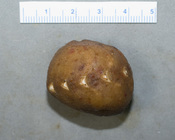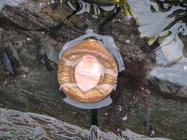
| Introduction | | Search taxa | | Taxon tree | | Taxon match | | Checklist | | Literature | | Stats | | Photogallery | | OBIS Vocab | | Log in |
WoRMS name detailsAmicula vestita (Broderip & G. B. Sowerby I, 1829)
159928 (urn:lsid:marinespecies.org:taxname:159928)
unaccepted > superseded combination
Species
Amicula emersonii (Couthouy, 1838) · unaccepted > junior subjective synonym
Amicula pallasii (Middendorff, 1847) · unaccepted > junior subjective synonym
Amicula rosea Yakovleva, 1952 · unaccepted
Chiton emersonianus A. Gould, 1841 · unaccepted > unjustified emendation (Unjustified emendation of Chiton...)
Unjustified emendation of Chiton emersonii Couthoy, 1838 Chiton emersonii Couthouy, 1838 · unaccepted
Chiton pallasii Middendorff, 1847 · unaccepted (a junior synonym)
Stimpsoniella emersonii (Couthouy, 1838) · unaccepted > junior subjective synonym
Stimpsoniella pallasii (Middendorff, 1847) · unaccepted > junior subjective synonym
Symmetrogephyrus pallasii (Middendorff, 1847) · unaccepted > junior subjective synonym
marine,
recent only
(of Chiton vestitus Broderip & G. B. Sowerby I, 1829) Broderip, W. J. & Sowerby, G. B. I. (1829). Observations on new or interesting Mollusca contained, for the most part, in the Museum of the Zoological Society. <em>Zoological Journal.</em> 4: 359-379, pl. 9. [January]., available online at http://biodiversitylibrary.org/page/27485275
page(s): 368 [details]
Note "Oceano Arctico", without a precise locality
Type locality "Oceano Arctico", without a precise locality [details]
Distribution Arctic Seas to Massachusetts
Distribution Arctic Seas to Massachusetts [details]
MolluscaBase eds. (2025). MolluscaBase. Amicula vestita (Broderip & G. B. Sowerby I, 1829). Accessed through: World Register of Marine Species at: https://www.marinespecies.org/aphia.php?p=taxdetails&id=159928 on 2025-05-04
Date action by
Nomenclatureoriginal description
(of Chiton vestitus Broderip & G. B. Sowerby I, 1829) Broderip, W. J. & Sowerby, G. B. I. (1829). Observations on new or interesting Mollusca contained, for the most part, in the Museum of the Zoological Society. <em>Zoological Journal.</em> 4: 359-379, pl. 9. [January]., available online at http://biodiversitylibrary.org/page/27485275 page(s): 368 [details] basis of record Brunel, P., L. Bosse & G. Lamarche. (1998). Catalogue of the marine invertebrates of the estuary and Gulf of St. Lawrence. <em>Canadian Special Publication of Fisheries and Aquatic Sciences, 126.</em> 405 pp. (look up in IMIS) [details] Available for editors Otheradditional source
Gosner, K. L. (1971). Guide to identification of marine and estuarine invertebrates: Cape Hatteras to the Bay of Fundy. <em>John Wiley & Sons, Inc., London.</em> 693 pp. [pdf copepod and branchiuran :445-455]. (look up in IMIS) [details] Available for editors
additional source Yakovleva, A. M. (1952). [in Russian] Shell-bearing Mollusks (Loricata) of the seas of the USSR. Fauna USSR no. 45: 107 pp, 53 figs., 11 pls. Zoological Institute, Academy of Sciences of the USSR, Moscow. page(s): 83, pl. VI, fig. 2 [details] additional source Bousfield, E.L. 1960. Canadian Atlantic sea shells. National Museum of Canada, Ottawa. 72 p. [details]  Present Present  Present in aphia/obis/gbif/idigbio Present in aphia/obis/gbif/idigbio  Inaccurate Inaccurate  Introduced: alien Introduced: alien  Containing type locality Containing type locality
From editor or global species database
Type locality "Oceano Arctico", without a precise locality [details]Unreviewed
Diet herbivores [details]Dimensions 25 to 50 mm [details] Distribution Arctic Seas to Massachusetts [details] Habitat bathyal, infralittoral and circalittoral of the Gulf and estuary [details] Reproduction sexes are separate but they are indistinguishable externally. fertilization is external and usually the eggs are shed into the water [details]
To Barcode of Life (3 barcodes)
To Biodiversity Heritage Library (44 publications) To Biodiversity Heritage Library (5 publications) (from synonym Symmetrogephyrus vestitus (Broderip & G. B. Sowerby I, 1829)) To European Nucleotide Archive, ENA (Amicula vestita) To GenBank (3 nucleotides; 2 proteins) To Malacopics (Amicula vestita (Broderip & G. B. Sowerby I, 1829)) To The Arctic Traits Database (0 traits) To USNM Invertebrate Zoology Mollusca Collection To Yale Peabody Museum of Natural History (YPM IZ 093833) To ITIS |



